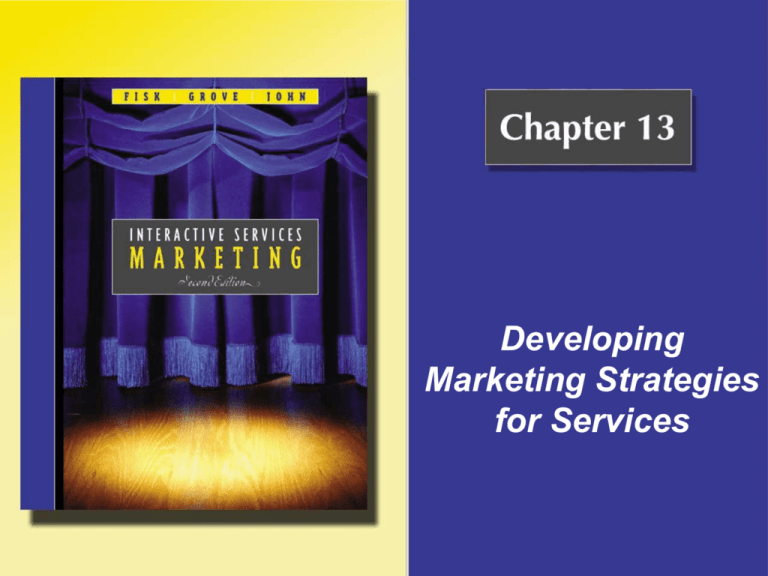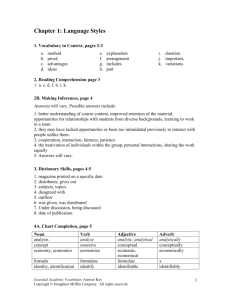
Developing
Marketing Strategies
for Services
Definition of Marketing Strategy
• The process of adjusting
controllable marketing
factors to cope with or
exploit uncontrollable
environmental forces.
Copyright © Houghton Mifflin Company. All rights reserved.
13 - 2
Copyright © Houghton Mifflin Company. All rights reserved.
13 - 3
Definition of Product Life Cycle
• The pattern of a product’s sales over
its lifetime.
• It passes through four stages:
• Introduction
• Growth
• Maturity
• Decline.
Copyright © Houghton Mifflin Company. All rights reserved.
13 - 4
Copyright © Houghton Mifflin Company. All rights reserved.
13 - 5
Definition of Environmental Scanning
• The process of carefully
monitoring external and
internal environments for
changes that pose threats or
opportunities to the service
organization.
Copyright © Houghton Mifflin Company. All rights reserved.
13 - 6
Copyright © Houghton Mifflin Company. All rights reserved.
13 - 7
Copyright © Houghton Mifflin Company. All rights reserved.
13 - 8
Definitions of Reactive
and Proactive Strategies
• Reactive strategy is a slow response
to environmental changes.
• Proactive strategy is a rapid
response to environmental changes.
• Defensive strategies – rapid responses
to protect the organization from
environmental threats.
• Offensive strategies – rapid responses
employed to capture opportunities.
Copyright © Houghton Mifflin Company. All rights reserved.
13 - 9
The External Services Environment
• Economic and competitive
environment – Rapid growth of the
service economy throughout the
world.
• Ethical and legal environment
• Ethics concern personal and
professional codes of values.
• Laws vary greatly across service
industries and countries.
Copyright © Houghton Mifflin Company. All rights reserved.
13 - 10
The External Services Environment (cont’d)
• Social, cultural, and demographic
environment
• Service industries have often been slow
to acknowledge importance of
responding to changing customer
tastes and preferences.
• Technology environment
• Technology is arguably the strongest
force shaping the external environment
of services.
Copyright © Houghton Mifflin Company. All rights reserved.
13 - 11
Planning the Services
Marketing Strategy
• Planning the strategy
• Determination of the service's
objectives and manner in which
they will be accomplished.
• Designing the strategy
• Careful specification of what it is
that the organization hopes to
accomplish.
Copyright © Houghton Mifflin Company. All rights reserved.
13 - 12
Planning the Services
Marketing Strategy
• Implementing the strategy
• Developing a detailed timetable
and itemized budget.
• Controlling the strategy
• Continuous assessment and
modification of the success of
strategies.
Copyright © Houghton Mifflin Company. All rights reserved.
13 - 13
Positioning and Segmentation
• Positioning
• How marketers attempt to create
favorable customer perceptions of their
product in relation to all other products.
• Market segmentation
• The division of a heterogeneous market
into homogeneous segments.
Copyright © Houghton Mifflin Company. All rights reserved.
13 - 14
Six Strategic Challenges for Services
1. Performance – Service performances must be
carefully planned with such techniques as
blueprinting, scripting, and dramatization.
2. Demand – Services must develop very flexible
systems to make their service supply meet the
demand.
3. Employees – Recruiting, training,
compensating, and motivating employees are
essential strategic factors for services.
Copyright © Houghton Mifflin Company. All rights reserved.
13 - 15
Six Strategic Challenges for Services (cont’d)
4. Setting – The setting is often the only tangible
representation of the service organization's
quality.
5. Customers – Because most service
organizations have more direct contact (than
manufacturers) with customers, they must be
very sensitive to customer needs.
6. Service quality – Numerous techniques are
available to measure and improve service
quality.
Copyright © Houghton Mifflin Company. All rights reserved.
13 - 16
Service Strategies for
Competitive Advantage
• Surpass Your Competition
• The term sur/petition was coined by Edward
de Bono (1992) to describe his concept of
surpassing the normal kinds of competition
by surpassing competitors.
• Dramatize Your Performance
• The most effective service organizations
learn to stage their performances.
• Build Relationships
• Strong customer relationships can lead to
customer loyalty.
Copyright © Houghton Mifflin Company. All rights reserved.
13 - 17
Service Strategies for
Competitive Advantage (cont’d)
• Harness Technology
• Modern communication and
transportation technology allow service
organizations to operate in multiple
countries, but maintain close contact
with employees and customers.
• Jazz Your Delivery
• Like great jazz musicians, great service
organizations are great improvisers.
Copyright © Houghton Mifflin Company. All rights reserved.
13 - 18
Strategy Implementation Issues
• Internal obstacles
•
•
•
•
Organizational culture
Weak incentives
Vision thing
Infighting – short-term vs. long-term goals
• External obstacles
•
•
•
•
Inertia
Resistance to change
Competition
Helpful “do-gooders”
• Government, organizations, citizens
Copyright © Houghton Mifflin Company. All rights reserved.
13 - 19
Strategy Implementation Issues (cont’d)
• Managing people
• The difficulty of driving change
• Managing budgets
• Understanding expenses and investments
• Underestimating revenues
• Overestimating costs
• Managing timetables
• Anticipating needs
• Contingency planning - what ifs
• Creating habits of success
Copyright © Houghton Mifflin Company. All rights reserved.
13 - 20
Solving the Implementation Trap –
Taking Action
• Hands-on leadership.
• Plain language, simple concepts.
• Ask “how,” not just “why.”
• Strong control mechanisms to
close the loop!
• Experience is the best teacher.
Source: Adapted from Pfeffer & Sutton (1999)
Copyright © Houghton Mifflin Company. All rights reserved.
13 - 21


